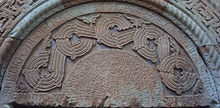Gurgen of Iberia
| Gurgen | |
|---|---|
| King of Kings of the Iberians | |
| Reign | 994-1008 |
| Predecessor | Bagrat II of Iberia |
| Successor | Bagrat III of Georgia |
| Died | 1008 |
| Spouse | Gurandukht of Abkhazia |
| Issue | Bagrat III of Georgia |
| Dynasty | Bagrationi dynasty |
| Father | Bagrat II of Iberia |
| Religion | Georgian Orthodox Church |
Gurgen (Georgian: გურგენი) also known as Gurgen Magistros, Gurgen II Magistros (also transliterated as Gourgen and in some sources Gurgan) of the Bagrationi dynasty, was King of Iberia-Kartli with the title of the King of Kings of the Georgians from 994 until his death in 1008. Magistros was a title bestowed upon him by the Byzantine Emperor Basil II.
Biography
Representative of the Kartli line of the Georgian Bagratids (Bagrationi) of Tao-Klarjeti, Gurgen was the son of Bagrat II, who reigned as King of the Georgians from 958 to 994. Gurgen was married to Gurandukht, a daughter of the Abkhazian king George II. She gave birth, in circa 960, to a son called Bagrat. The latter was adopted by his kinsman, the powerful prince David III Kuropalates of Tao/Tayk, as his heir. In 975, Bagrat, still in his teens, was installed by David as a ruler in Kartli under the regency of Gurgen. Three years later, Bagrat was crowned King of the Abkhazians, while Gurgen remained his co-ruler in the Kartlian lands and helped his son in an uncompromised struggle against the aristocratic opposition.

In 989, Bagrat planned to inflict a final blow to the powerful noble Rati of Kldekari who held a large fiefdom in Trialeti. Gurgen, together with his army, was waiting for his son at the boundary of Shavsheti, when David of Tao, being misinformed that his kinsmen intended to ambush his possessions, dispersed Gurgen’s troops in a sudden attack, forcing him to flee to the fortress of Tsep’ti. In this brief conflict Gurgen’s father, Bagrat II, sided with David. The Bagratids subsequently reconciled, but David’s unsuccessful uprising against the Byzantine Empire and an ensuing treaty with Emperor Basil II destroyed a previous arrangement, by which David had made his adopted son, Bagrat (Gurgen’s son) his heir to his extensive principality.
In 994, Bagrat II died, and Gurgen succeeded him, crowning himself King of Kings of the Georgians. This kingdom comprised Hither Tao, Shavsheti, Meskheti, Javakheti, Ajaria and some minor lands in historic Tao-Klarjeti. Upon David of Tao’s death in 1000, Gurgen, and Bagrat met with Basil but, unable to prevent the annexation of David’s realm to the Byzantine Empire, were forced to recognize the new borders. On this occasion, Bagrat was bestowed with the Byzantine title of kuropalates, and Gurgen with that of magistros, actually the competing titles since the dignity conferred upon the son was more esteemed than that granted to the father. This was done by the emperor, as the Georgian chronicles relate, to turn Gurgen against Bagrat, but he seriously miscalculated. Later the same year, Gurgen attempted to take David Kuropalates’ succession by force, but the Byzantine commander Nikephoros Ouranos, dux of Antioch, made him retreat.
Legacy
Gurgen died in 1008, leaving his throne to his son, King Bagrat of Abkhazia, enabling the latter to become the first king of a unified Georgian realm.
Genealogy
| Georgian monarchs family tree of Bagrationi dynasty of Tao-Klarjeti[1][2] | |||||||||||||||||||||||||||||||||||||||||||||||||||||||||||||||||||||||||||||||||||||||||||||||||||||||||||||||||||||||||||||||||||||||||||||||||||||||||||||||||||||||||||||||||||||||||||||||||||||||||||||||||||||||||||||||||||||||||||||||||||||||||||||||||||||||||||||||||||||||||||||||||||||||||||||||||||||||||||||||||||||||||||||||||||||||||||||||||||||||||||||||||||||||||||||||||||||||||||||||||||||||||||||||||||||||||||||||||||||||||||||||||||||||||||||||||||||||||||||||||||||||||||||||||||||||||||||||||||||||||||||||||||||||||||||||||||||||||||||||||||||||||||||||||||||||||||||||||||||||||||||||||||||||||||||||||||||||||||||||||||||||||||||||||||||||||||||||||||||||||||||||||||||||||||||||||||||||||||||||||||||||||||||||||||||||||||||||||||||||||||||||||||||||||||||||||||||||||||||||||||||||||||||||||||||||||||||||||||||||||||||||||||||||||||||||||||||||||||||||||||||||||||||||||||||||||||||||||||||||||||||||||||||||||||||||||||||||||||||||||||||||||||||||||||||||||||||||||||||||
|---|---|---|---|---|---|---|---|---|---|---|---|---|---|---|---|---|---|---|---|---|---|---|---|---|---|---|---|---|---|---|---|---|---|---|---|---|---|---|---|---|---|---|---|---|---|---|---|---|---|---|---|---|---|---|---|---|---|---|---|---|---|---|---|---|---|---|---|---|---|---|---|---|---|---|---|---|---|---|---|---|---|---|---|---|---|---|---|---|---|---|---|---|---|---|---|---|---|---|---|---|---|---|---|---|---|---|---|---|---|---|---|---|---|---|---|---|---|---|---|---|---|---|---|---|---|---|---|---|---|---|---|---|---|---|---|---|---|---|---|---|---|---|---|---|---|---|---|---|---|---|---|---|---|---|---|---|---|---|---|---|---|---|---|---|---|---|---|---|---|---|---|---|---|---|---|---|---|---|---|---|---|---|---|---|---|---|---|---|---|---|---|---|---|---|---|---|---|---|---|---|---|---|---|---|---|---|---|---|---|---|---|---|---|---|---|---|---|---|---|---|---|---|---|---|---|---|---|---|---|---|---|---|---|---|---|---|---|---|---|---|---|---|---|---|---|---|---|---|---|---|---|---|---|---|---|---|---|---|---|---|---|---|---|---|---|---|---|---|---|---|---|---|---|---|---|---|---|---|---|---|---|---|---|---|---|---|---|---|---|---|---|---|---|---|---|---|---|---|---|---|---|---|---|---|---|---|---|---|---|---|---|---|---|---|---|---|---|---|---|---|---|---|---|---|---|---|---|---|---|---|---|---|---|---|---|---|---|---|---|---|---|---|---|---|---|---|---|---|---|---|---|---|---|---|---|---|---|---|---|---|---|---|---|---|---|---|---|---|---|---|---|---|---|---|---|---|---|---|---|---|---|---|---|---|---|---|---|---|---|---|---|---|---|---|---|---|---|---|---|---|---|---|---|---|---|---|---|---|---|---|---|---|---|---|---|---|---|---|---|---|---|---|---|---|---|---|---|---|---|---|---|---|---|---|---|---|---|---|---|---|---|---|---|---|---|---|---|---|---|---|---|---|---|---|---|---|---|---|---|---|---|---|---|---|---|---|---|---|---|---|---|---|---|---|---|---|---|---|---|---|---|---|---|---|---|---|---|---|---|---|---|---|---|---|---|---|---|---|---|---|---|---|---|---|---|---|---|---|---|---|---|---|---|---|---|---|---|---|---|---|---|---|---|---|---|---|---|---|---|---|---|---|---|---|---|---|---|---|---|---|---|---|---|---|---|---|---|---|---|---|---|---|---|---|---|---|---|---|---|---|---|---|---|---|---|---|---|---|---|---|---|---|---|---|---|---|---|---|---|---|---|---|---|---|---|---|---|---|---|---|---|---|---|---|---|---|---|---|---|---|---|---|---|---|---|---|---|---|---|---|---|---|---|---|---|---|---|---|---|---|---|---|---|---|---|---|---|---|---|---|---|---|---|---|---|---|---|---|---|---|---|---|---|---|---|---|---|---|---|---|---|---|---|---|---|---|---|---|---|---|---|---|---|---|---|---|---|---|---|---|---|---|---|---|---|---|---|---|---|---|---|---|---|---|---|---|---|---|---|---|---|---|---|---|---|---|---|---|---|---|---|---|---|---|---|---|---|---|---|---|---|---|---|---|---|---|---|---|---|---|---|---|---|---|---|---|---|---|---|---|---|---|---|---|---|---|---|---|---|---|---|---|---|---|---|---|---|---|---|---|---|---|---|---|---|---|---|---|---|---|---|---|---|---|---|---|---|---|---|---|---|---|---|---|---|---|---|---|---|---|---|---|---|---|---|---|---|---|---|---|---|---|---|---|---|---|---|---|---|---|---|---|---|---|---|---|---|---|---|---|---|---|---|---|---|---|---|---|---|---|---|---|---|---|---|---|---|---|---|---|---|---|---|---|---|---|---|---|---|---|---|---|---|---|---|---|---|---|---|---|---|---|---|---|---|---|---|---|---|---|---|---|---|---|---|---|---|---|---|---|---|---|---|---|---|---|---|---|---|---|---|---|---|---|---|---|---|---|---|---|---|---|---|---|---|---|---|---|---|---|---|---|---|---|---|---|---|---|---|---|---|---|---|---|---|---|---|---|---|---|---|---|---|---|---|---|---|---|---|---|---|---|---|---|---|---|---|---|---|---|---|---|---|---|---|---|---|---|---|---|---|---|---|---|---|---|---|---|---|---|---|---|---|---|---|---|---|---|---|---|---|---|---|---|---|---|---|---|---|---|---|---|---|---|---|---|---|---|---|---|---|---|---|---|---|---|---|---|---|
| |||||||||||||||||||||||||||||||||||||||||||||||||||||||||||||||||||||||||||||||||||||||||||||||||||||||||||||||||||||||||||||||||||||||||||||||||||||||||||||||||||||||||||||||||||||||||||||||||||||||||||||||||||||||||||||||||||||||||||||||||||||||||||||||||||||||||||||||||||||||||||||||||||||||||||||||||||||||||||||||||||||||||||||||||||||||||||||||||||||||||||||||||||||||||||||||||||||||||||||||||||||||||||||||||||||||||||||||||||||||||||||||||||||||||||||||||||||||||||||||||||||||||||||||||||||||||||||||||||||||||||||||||||||||||||||||||||||||||||||||||||||||||||||||||||||||||||||||||||||||||||||||||||||||||||||||||||||||||||||||||||||||||||||||||||||||||||||||||||||||||||||||||||||||||||||||||||||||||||||||||||||||||||||||||||||||||||||||||||||||||||||||||||||||||||||||||||||||||||||||||||||||||||||||||||||||||||||||||||||||||||||||||||||||||||||||||||||||||||||||||||||||||||||||||||||||||||||||||||||||||||||||||||||||||||||||||||||||||||||||||||||||||||||||||||||||||||||||||||||||
Notes
- ^ Adarnase IV restored Georgian kingship in 888[3] as the Kingdom of the Iberians and this would go on to dominate the political life of Georgia for a thousand years.[4]
- ^ David III, being childless, took advice from the Georgian aristocracy and adopted his kin, prince Bagrat in 975.[5] This will lead and pave the way for the unification of Georgia.[6]
- ^ King Bagrat III, the first monarch of unified Georgia was ruthless in his state administration. While visiting Castle of Panaskerti in Tao, king summoned his two cousins, Sumbat III and Gurgen. They were arrested and executed. Sumbat’s son Bagrat, and Gurgen’s son Demetrius, escaped to the Byzantine Empire. The Bagrationi line of Tao was already extinct since 941;[7] now with purging his own cousins the line of Klarjeti was also gone and no rival could ever claim the Georgian throne.[8]
References
Bibliography
- Rayfield, D. (2013) Edge of Empires: A History of Georgia, Reaktion Books, ISBN 9781780230702
- Rapp, S. H. Jr. (2016) The Sasanian World Through Georgian Eyes, Caucasia and the Iranian Commonwealth in Late Antique Georgian Literature, Sam Houston State University, USA, Routledge, ISBN 9781472425522
- Settipani, C. (2006) Continuité des élites à Byzance durant les siècles obscurs. Les princes caucasiens et l'Empire du VIe au IXe siècle, Paris, ISBN 9782701802268
References
- Lordkipanidze, Mariam (1967), Georgia in the XI-XII centuries, Ganatleba, edited by George B. Hewitt. Also available online at [1]
- Rapp, SH (2003), Studies In Medieval Georgian Historiography: Early Texts And Eurasian Contexts, Peeters Bvba ISBN 978-90-429-1318-9
- Suny, RG (1994), The Making of the Georgian Nation (2nd Edition), Bloomington and Indianapolis, ISBN 978-0-253-35579-9
